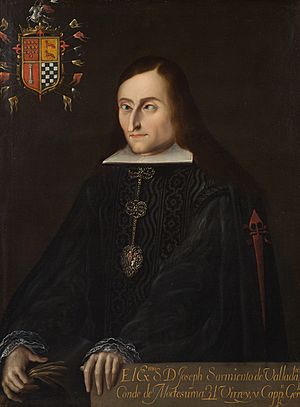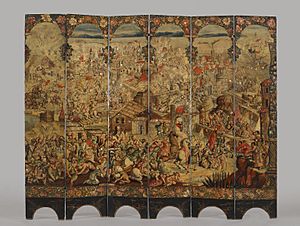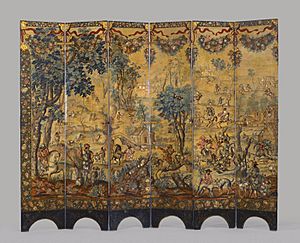José Sarmiento de Valladares, 1st Duke of Atrisco facts for kids
Quick facts for kids
The Duke of Atrisco
|
|
|---|---|
 |
|
| Viceroy of New Spain | |
| In office December 18, 1696 – November 3, 1701 |
|
| Monarch | Charles II |
| Preceded by | Juan Ortega y Montañés |
| Succeeded by | Juan Ortega y Montañés |
| Personal details | |
| Born | May 4, 1643 San Roman de Saxamonde, Galicia, Spain |
| Died | September 10, 1708 (aged 65) Madrid, Spain |
| Spouse | María Jerónima Moctezuma y Jofre de Loaiza |
José Sarmiento de Valladares Arines-Troncoso de Romay was an important Spanish leader. He was the 1st Duke of Atrisco and also known as the Count of Moctezuma. He served as the Viceroy of New Spain (which is now Mexico) from 1696 to 1701.
José Sarmiento was born in May 1643 in a place called San Roman de Saxamonde, in Galicia, Spain. He passed away in Madrid, Spain, on September 10, 1708.
Contents
His Time as Viceroy
When José Sarmiento arrived in New Spain, he first met the previous viceroy, Bishop Juan Ortega y Montañés. This meeting happened in a town called Otumba, on the way to Mexico City.
He entered the capital city quietly on December 18, 1696. Later that evening, he officially took his oath of office. On February 2, 1697, during his grand entrance into Mexico City, his horse stumbled and fell. This caused a lot of laughter among the people watching!
Helping the People
José Sarmiento worked hard to help the people during a time of great hunger in 1697. He ordered that large amounts of corn and wheat be stored in public buildings. This was to make sure there would be enough food if another famine happened. He also made sure other important supplies were stored.
He arranged for ships from the Philippines to bring mercury to New Spain. Mercury was very important for getting silver out of the mines. Many mines had closed because they didn't have enough mercury. He also made it legal for native people to drink pulque, a mild alcoholic drink.
The viceregal palace had been damaged in riots and a fire in 1692. José Sarmiento worked to fix it up. He was able to move into the restored palace on May 25, 1697. Sadly, one of his daughters, Fausta Dominga, died shortly after from smallpox.
Keeping the City Safe
In 1700, José Sarmiento started a night watch system in Mexico City to fight crime. The city was divided into eight areas. A police officer was in charge of the night watch in each area.
There were strict rules for criminals. For a first crime, offenders were publicly whipped. For a second crime, they were branded on their back. If they committed a third crime, they would lose an ear. On March 6, 1700, he ordered that anyone attacking travelers on the main road (Camino Real) would be put to death. He also sent criminals to Puerto Rico.
End of His Term
On March 6, 1701, a ship arrived in Veracruz with important news. King Charles II of Spain had died on November 1, 1700. King Charles II did not have any children to take his place. This led to a big conflict called the War of the Spanish Succession. This war was fought to decide who would become the next king of Spain.
José Sarmiento was known to support the Habsburg family's claim to the Spanish throne. However, the Bourbon family was gaining power in Spain. Because of this, José Sarmiento was removed from his position as viceroy. He was ordered to return to Spain. Bishop Juan Ortega y Montañés became the interim viceroy once again.
Even though he was removed from office, José Sarmiento received many honors when he returned to Spain. He was given a pension (money paid regularly) and new titles. These included the Duke of Atlixco and a Grandee of Spain. He received these titles on November 25, 1704. He passed away in Madrid in 1708.
His Family Life
José Sarmiento was married to María Jerónima Moctezuma y Jofre de Loaiza. She was the third Countess de Moctezuma and a descendant of the last Aztec emperor. He received his title through her. They had two daughters before she passed away.
After her death, he married again. His second wife was a granddaughter of the Marquess de Villamanrique. She traveled with him to New Spain.
Today, his family members still hold the title Duke of Atrisco in Spain. Another part of his family, the Romay branch, lives in Mexico.
See also
 In Spanish: José Sarmiento Valladares para niños
In Spanish: José Sarmiento Valladares para niños



